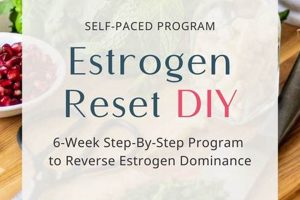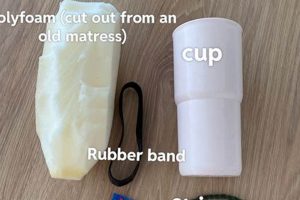Homemade versions of pre-packaged, compartmentalized meals offer a customizable and often healthier alternative. These involve assembling individual food items, such as crackers, cheese slices, and deli meats, into a single container for convenient consumption, particularly for school lunches or on-the-go snacks. An example is a collection of whole-wheat crackers, cheddar cheese cubes, and lean turkey slices arranged in a divided container.
Creating these personalized meal packs provides benefits that include greater control over ingredients, leading to potentially more nutritious options with lower sodium and fewer preservatives. Moreover, this approach allows for the incorporation of individual preferences, addressing dietary needs and reducing food waste. Historically, the pre-packaged counterparts gained popularity due to convenience, but the homemade option prioritizes health and personalization.
The remainder of this exploration will delve into specific strategies for building such customized meal packs, including considerations for ingredient selection, storage techniques, and presentation ideas to enhance appeal. Further discussion will address cost-effectiveness and time-saving tips for efficient preparation.
Creating Customized Meal Packs
The following outlines crucial steps to ensure the successful creation and implementation of personalized, compartmentalized meal solutions. These considerations address nutrition, storage, and efficiency.
Tip 1: Prioritize Nutritional Balance: Include items from multiple food groups. Ensure a balance of protein (lean meats, cheese), carbohydrates (whole-grain crackers, fruits), and healthy fats (nuts, avocado) in each container.
Tip 2: Select High-Quality Ingredients: Opt for minimally processed foods with reduced sodium and sugar content. Fresh produce and whole grains contribute to a more nutritious outcome.
Tip 3: Focus on Portion Control: Pre-portion ingredients to manage calorie intake and prevent overeating. Utilizing smaller containers or dividers aids in portion regulation.
Tip 4: Employ Proper Food Safety Practices: Maintain cold chain integrity. Use insulated lunch bags with ice packs to keep perishable items at a safe temperature (below 40F) until consumption.
Tip 5: Prepare in Advance: Allocate time for assembling multiple meal packs simultaneously. This saves time during the week and ensures consistent availability.
Tip 6: Utilize Reusable Containers: Invest in durable, reusable containers with tight-fitting lids to prevent leakage and maintain freshness. Opt for BPA-free options for health and safety.
Tip 7: Incorporate Variety: Rotate ingredients regularly to prevent monotony and ensure a broader range of nutrients. Experiment with different combinations of flavors and textures.
Tip 8: Consider Presentation: Arrange items attractively to enhance appeal, especially for children. Using cookie cutters to shape cheese or arranging fruits in patterns can increase consumption.
Adhering to these recommendations will result in cost-effective, nutritious, and appealing compartmentalized meals that are tailored to individual needs and preferences. Benefits include improved control over dietary intake, reduced food waste, and increased convenience.
The subsequent section will examine potential cost-saving strategies and address common challenges encountered when preparing these personalized meal solutions.
1. Ingredient Quality
Ingredient quality serves as a foundational element in the successful execution and overall benefit derived from homemade compartmentalized meals. The selection of high-quality ingredients directly affects the nutritional profile, flavor, and safety of these lunch solutions. Poor ingredient choices can negate the advantages of preparing meals from scratch, potentially introducing excessive sodium, unhealthy fats, and artificial additives, thereby diminishing health benefits. As an example, opting for processed deli meats laden with preservatives, rather than fresh, lean cuts of poultry or ham, compromises the intended nutritional advantage of the homemade approach.
The impact of ingredient quality extends beyond nutritional considerations. Superior ingredients contribute to enhanced flavor, resulting in greater satisfaction and adherence to healthy eating habits. Fresh, ripe fruits, high-quality cheeses, and whole-grain crackers elevate the overall eating experience compared to processed or pre-packaged alternatives. Furthermore, choosing ingredients with minimal processing reduces exposure to potentially harmful chemicals and additives, promoting long-term health and well-being. A direct cause-and-effect relationship exists: higher quality inputs result in a superior and more nutritious output.
In summary, ingredient quality is not merely a secondary consideration but a crucial determinant of the success and value of homemade compartmentalized lunches. Prioritizing fresh, minimally processed ingredients, while avoiding those high in sodium, unhealthy fats, and artificial additives, is essential for maximizing the health benefits and ensuring a satisfying and nutritious meal. The practical significance of this understanding lies in its direct influence on individual well-being and long-term dietary habits, further enabling a more sustainable and healthier approach to meal preparation.
2. Nutritional Balance
Nutritional balance forms a cornerstone of successful homemade, compartmentalized lunches. The deliberate assembly of these meals allows for precise control over macronutrient and micronutrient content, addressing dietary requirements more effectively than pre-packaged alternatives. An imbalanced meal, regardless of its convenience, can lead to energy fluctuations, impaired cognitive function, and long-term health consequences. For example, a lunch consisting solely of processed carbohydrates offers limited sustained energy compared to a balanced combination of lean protein, whole grains, and healthy fats. The impact on concentration and productivity, particularly in children and adolescents, can be significant. Conversely, a well-balanced meal promotes satiety, supports optimal bodily functions, and contributes to overall well-being. The ability to customize these meals ensures that individuals with specific dietary needs, such as those managing diabetes or food allergies, can maintain adequate nutrition without compromising convenience.
Practical applications of nutritional balance in homemade meal packs include strategic ingredient selection and portion control. The inclusion of diverse food groups proteins, carbohydrates, fats, vitamins, and minerals is paramount. Lean protein sources like turkey or chicken provide essential amino acids, while whole-grain crackers or vegetables offer sustained energy. Healthy fats, such as avocado or nuts, contribute to satiety and
support hormone production. Precise portioning prevents overconsumption of less nutritious elements, such as refined sugars or processed snacks. An example involves replacing sugary juice boxes with water or unsweetened beverages and substituting processed chips with fresh fruit or vegetables. These modifications, driven by a focus on nutritional balance, yield significant health benefits and promote healthier eating habits.
In summary, prioritizing nutritional balance in homemade, compartmentalized lunches is crucial for optimizing health outcomes and supporting individual well-being. The ability to control ingredient selection and portion sizes allows for the creation of meals tailored to specific dietary needs and preferences. Addressing the challenge of time constraints requires advance planning and strategic meal preparation. The integration of these principles fosters healthier eating habits and contributes to a more sustainable and nutritious lifestyle. These personalized meal solutions offer a tangible pathway to improved nutrition and long-term health.
3. Portion Control
Portion control is a critical aspect in the creation of homemade, compartmentalized meals, directly influencing caloric intake, nutrient balance, and overall dietary health. The ability to precisely manage quantities differentiates these from pre-packaged options, where portion sizes are often predetermined and potentially excessive.
- Reduced Caloric Intake
Homemade meal preparation facilitates the setting of appropriate serving sizes for each component, mitigating the risk of overconsumption. For instance, pre-packaged snacks often contain larger portions than required for a single serving, contributing to excess caloric intake. DIY solutions allow for precise measurement and control of caloric density.
- Balanced Macronutrient Distribution
Accurate portioning enables the creation of meals with the correct ratios of proteins, carbohydrates, and fats. This is particularly relevant for individuals following specific dietary plans or managing health conditions requiring macronutrient control. A controlled portion of lean protein, for example, supports muscle maintenance without excess calories.
- Minimized Food Waste
Portion control directly reduces food waste by preparing only the necessary amount for a single meal. This minimizes the likelihood of uneaten leftovers and promotes efficient resource utilization. Planning portion sizes according to individual needs and preferences contributes to sustainability.
- Enhanced Dietary Awareness
The act of measuring and portioning ingredients fosters a greater awareness of food quantity and its impact on overall dietary intake. This heightened awareness can translate into improved eating habits beyond compartmentalized meals, promoting a more mindful approach to food consumption.
In summary, portion control is a key advantage of DIY lunchables, allowing for tailored meals that support individual health goals and dietary requirements. The ability to precisely manage portion sizes distinguishes these homemade solutions from pre-packaged alternatives, promoting improved dietary outcomes and reducing food waste. The conscious effort invested in portioning enhances dietary awareness and contributes to sustainable eating habits.
4. Food Safety
Food safety represents a critical consideration in the preparation and consumption of homemade, compartmentalized meals. The prevention of foodborne illnesses requires meticulous attention to detail throughout the entire process, from ingredient selection to storage and handling.
- Temperature Control
Maintaining proper temperatures is paramount to inhibiting bacterial growth. Perishable items, such as meats, cheeses, and dairy products, must be kept refrigerated below 40F (4C) until consumption. The use of insulated lunch bags with ice packs or frozen gel packs is essential to maintaining a safe temperature during transport and storage.
- Cross-Contamination Prevention
Cross-contamination occurs when harmful bacteria transfer from one food to another. Raw meats should be kept separate from ready-to-eat foods. Utensils and cutting boards used for raw meats must be thoroughly washed and sanitized before being used for other ingredients. Proper handwashing before, during, and after food preparation is also crucial.
- Ingredient Sourcing and Handling
The selection of fresh, high-quality ingredients from reputable sources minimizes the risk of contamination. Thoroughly washing fruits and vegetables under running water removes surface contaminants. Expiration dates should be carefully monitored, and any questionable items discarded.
- Safe Storage Practices
Once assembled, compartmentalized meals should be stored in airtight containers to prevent contamination and maintain freshness. Containers should be properly labeled with the date of preparation to ensure timely consumption. Meals should be consumed within a reasonable timeframe to minimize the risk of bacterial growth, typically within a few hours if not refrigerated.
Adherence to these food safety principles is non-negotiable when preparing DIY lunchables. Neglecting these guidelines can lead to foodborne illnesses, negating the benefits of a homemade meal. Diligence in food handling, preparation, and storage represents the cornerstone of safe and healthy meal consumption. This proactive approach ensures that the advantages of customized, compartmentalized lunches are not compromised by preventable health risks.
5. Cost-Effectiveness
The cost-effectiveness of creating homemade compartmentalized meals represents a significant advantage over purchasing pre-packaged alternatives. While the initial investment in reusable containers and ingredients may appear higher, the long-term savings potential is substantial. Pre-packaged lunch options often contain highly processed ingredients and excessive packaging, contributing to a higher unit cost. Conversely, purchasing bulk ingredients and assembling meals at home allows for greater control over spending and reduced waste. The cause-and-effect relationship is direct: reduced reliance on pre-packaged items translates to lower overall food expenditures.
The importance of cost-effectiveness as a component of DIY lunchables lies in its accessibility. By making healthier and more customizable meals affordable, it enables broader adoption across various socioeconomic groups. Real-life examples illustrate this point; families substituting pre-packaged lunches with homemade options containing whole-grain bread, deli meat, and fresh fruit report monthly savings, sometimes significant. This economic advantage extends beyond direct food costs, as reduced consumption of processed foods can correlate with improved health outcomes, potentially minimizing healthcare expenses. Practical application involves strategic meal planning, utilizing seasonal produce, and leveraging bulk discounts to further optimize cost savings.
In summary, the cost-effectiveness of preparing homemade compartmentali
zed meals presents a compelling argument for their adoption. The long-term financial benefits, coupled with enhanced nutritional control and reduced waste, contribute to a more sustainable and budget-friendly approach to meal preparation. While initial effort is required, the potential for substantial savings and improved health makes DIY lunchables a pragmatic choice for individuals and families seeking to optimize their food expenditures and dietary habits.
6. Time Efficiency
Time efficiency is a crucial consideration when evaluating the practicality of homemade, compartmentalized meals. The perceived time investment often acts as a barrier to adoption, especially for individuals with demanding schedules. The preparation of individual lunch components, as opposed to the immediate availability of pre-packaged options, requires advance planning and dedicated time allocation. The cause and effect relationship is clear: time constraints can directly impede the consistent preparation and consumption of these healthier meal alternatives. If preparation time becomes excessive, adherence to a DIY lunchable regimen is unlikely.
However, strategic planning and optimized workflows can significantly enhance time efficiency. Real-life examples illustrate this point: individuals who dedicate a block of time on weekends to prepare multiple meal packs for the week can substantially reduce daily preparation time. Utilizing pre-cut vegetables, pre-cooked proteins, and readily available whole-grain crackers streamlines the process. Furthermore, involving family members in the preparation process distributes the workload and promotes collaborative meal planning. Batch cooking and leveraging leftovers further reduce the time required for daily lunch assembly. This highlights the importance of planning to the success of the task. Implementing organizational systems improves efficiency and reduces workload.
In summary, while the initial perception may be that DIY lunchables are time-consuming, strategic planning and efficient preparation techniques can mitigate this concern. The long-term benefits of cost savings, improved nutrition, and reduced waste often outweigh the initial time investment. Addressing the challenge of time constraints requires a proactive approach to meal planning and a willingness to adopt time-saving strategies. In doing so, individuals can effectively integrate homemade, compartmentalized meals into their routines, reaping the rewards of healthier eating habits and reduced reliance on pre-packaged alternatives. This allows for better nutritional choices, waste reduction, and saves money.
7. Customization
Customization is central to the concept and execution of do-it-yourself (DIY) lunchables. It allows individuals to tailor meal components to meet specific dietary needs, preferences, and health goals, thereby enhancing the overall value and utility of these homemade alternatives.
- Dietary Requirements
Customization permits the exclusion or inclusion of specific ingredients to accommodate allergies, intolerances, or other dietary restrictions. For example, gluten-free crackers can replace conventional wheat-based crackers for individuals with celiac disease. Similarly, dairy-free cheese alternatives can be incorporated for those with lactose intolerance. This adaptability is a core advantage over pre-packaged options with fixed ingredient lists.
- Nutritional Goals
Individuals seeking to achieve particular nutritional targets, such as increased protein intake or reduced sugar consumption, can leverage customization to assemble meals aligning with those objectives. Incorporating lean protein sources, such as grilled chicken or turkey breast, and opting for fresh fruits over processed snacks are examples. Precise control over macronutrient ratios contributes to achieving specific health and fitness goals.
- Flavor Preferences
Customization enables the incorporation of preferred flavors and textures, enhancing the overall enjoyment of the meal. Individuals can select specific types of cheese, deli meats, or vegetables that align with their taste preferences. This personalization can increase the likelihood of consistent consumption and adherence to healthy eating habits.
- Portion Control
Customization inherently facilitates portion control by allowing individuals to dictate the quantities of each component. This is particularly relevant for managing caloric intake and promoting weight management. Utilizing smaller containers or pre-portioning ingredients ensures that meals align with individual caloric needs and prevent overconsumption.
The multifaceted nature of customization underscores its importance in DIY lunchables. By addressing dietary needs, nutritional goals, flavor preferences, and portion control, customization transforms these homemade meal solutions into a versatile and adaptable approach to healthy eating. The absence of such customization in pre-packaged alternatives highlights the distinct value proposition of DIY lunchables and their potential to support individualized dietary strategies.
Frequently Asked Questions
This section addresses common inquiries regarding the preparation and benefits of constructing customized, pre-portioned meal solutions.
Question 1: Are homemade compartmentalized meals truly more cost-effective than pre-packaged options?
While initial investment in reusable containers and bulk ingredients may be required, long-term savings are typically realized due to reduced reliance on processed foods and minimized packaging costs. Strategic planning and leveraging sales enhance cost-effectiveness.
Question 2: How can sufficient time be allocated for preparing these meals within a busy schedule?
Dedicated meal preparation sessions on weekends, utilizing pre-cut ingredients, and batch cooking are effective strategies. Involving other household members can also distribute the workload and streamline the process.
Question 3: What are the essential food safety precautions for preventing foodborne illnesses?
Maintaining proper temperatures with insulated lunch bags and ice packs, preventing cross-contamination through separate cutting boards, and ensuring thorough handwashing are crucial. Consuming meals within a safe timeframe is equally important.
Question 4: How can nutritional balance be ensured within these compartmentalized meals?
Including items from all major food groups proteins, carbohydrates, and fats is paramount. Lean protein sources, whole grains, and healthy fats should be prioritized, while minimizing processed ingredients and added sugars.
Question 5: What types of containers are best suited for constructing these homemade meal packs?
Reusable containers with tight-fitting lids, constructed from BPA-free materials, are recommended. Compartmentalized containers simplify organization and portion control. Durability and ease of cleaning are important considerations.
Question 6: How can dietary needs and preferences be accommodated within these meal solutions?
Ingredient selection can be tailored to address specific allergies, intolerances, or dietary restrictions. Alternatives such as gluten-free crackers,
dairy-free cheeses, and nut-free spreads allow for complete customization.
These answers underscore the key benefits and considerations associated with creating homemade compartmentalized meals. The discussed aspects promote informed decision-making.
The following segment explores advanced strategies for enhancing the nutritional value and appeal of these personalized meal solutions.
Conclusion
This exploration has detailed the multifaceted nature of diy lunchables, examining their nutritional, economic, and practical implications. The ability to control ingredients, manage portion sizes, and customize meals to individual needs distinguishes homemade options from pre-packaged alternatives. Considerations of food safety, time efficiency, and cost-effectiveness are paramount to the successful implementation of this approach. Ingredient choice, nutritional balance and the right containers plays the key factor for success in implementing this method.
The ongoing emphasis on healthy eating and sustainable living underscores the enduring relevance of diy lunchables. Continued research into innovative storage solutions, efficient preparation techniques, and nutritionally optimized recipes will further enhance the appeal and accessibility of these customized meal solutions. The long-term impact of promoting mindful eating habits and reducing reliance on processed foods warrants continued attention and advocacy. Ultimately, the advantages for the health and family are worth the time and effort.







